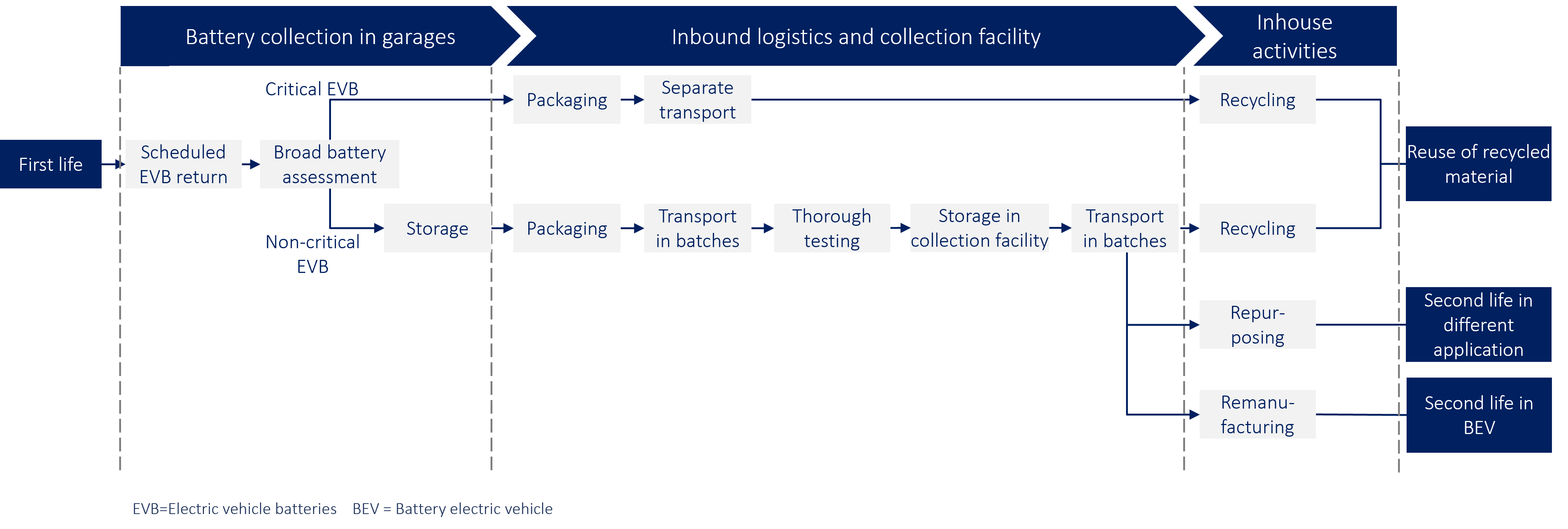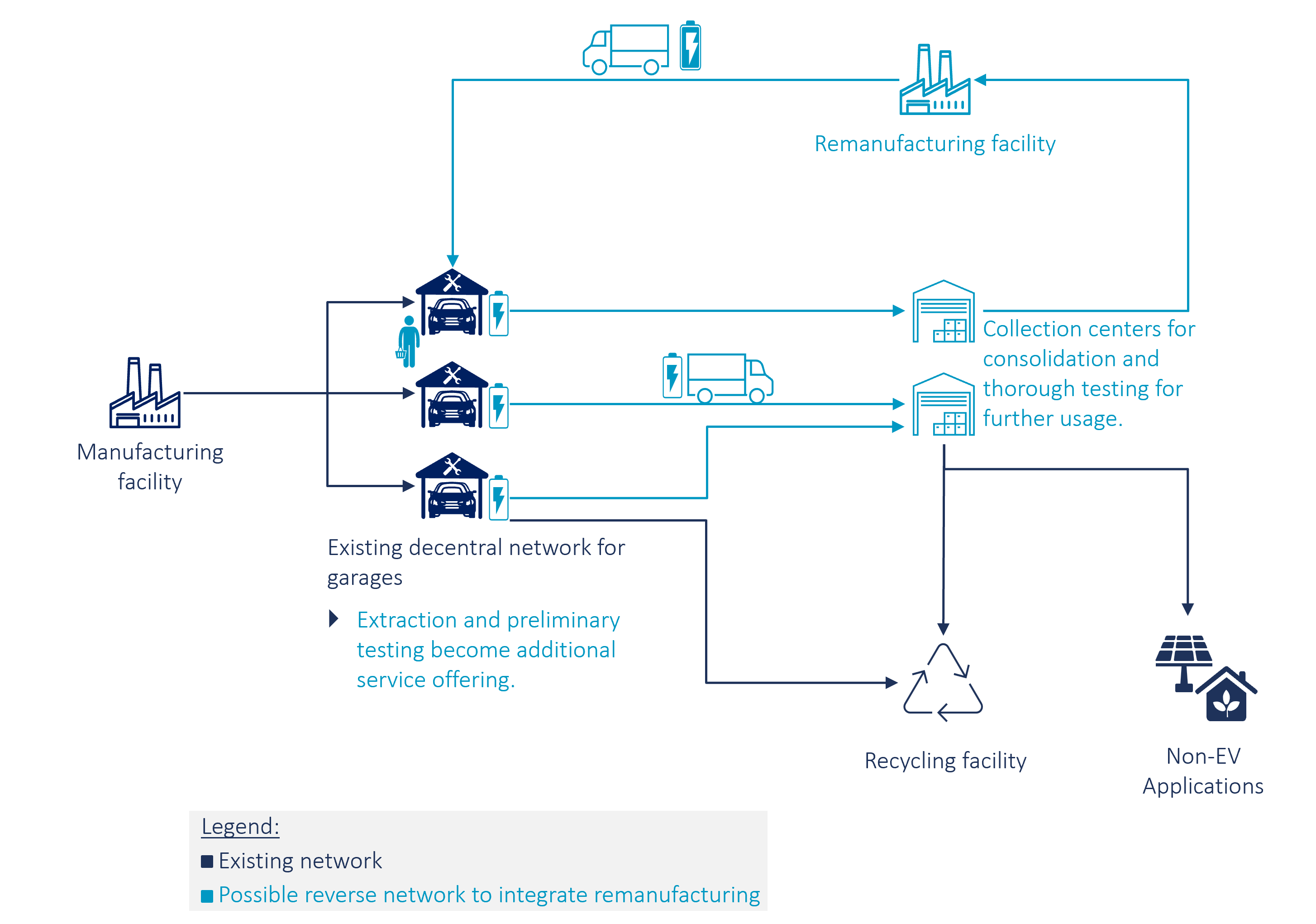This blog article addresses strategic considerations that organizations need to cover when establishing an efficient reverse supply chain for the remanufacturing of electric vehicle batteries.
As an ever-increasing number of batteries from battery electric vehicles (BEVs) are reaching their end of life, the question of their further usage comes into focus. Currently, mostly recycling and second-use options are implemented. Looking at the commonly known waste-hierarchy, remanufacturing should be preferred to recycling, as explained in our blog-articles on battery management.
In order to reap the benefits of remanufacturing that are already discussed in this previous article about battery remanufacturing, a well-designed reverse supply chain is vital. For a company that wants to engage in battery remanufacturing, it is recommended to develop a strategy to reclaim used batteries as soon as possible, as these batteries are the necessary input for remanufacturing. The first companies to delve into this market will be at a significant advantage, as they will be able to freely choose partners for collaborations to exploit efficiencies in the joint management of a forward and reverse supply chain.
This blog post entails first insights into several long-term strategic considerations for the implementation of a reverse supply chain for remanufacturing of electric vehicle batteries (EVBs). To engage in efficient remanufacturing operations, a well-designed reverse supply chain is a prerequisite. The technical details for battery remanufacturing are explored in this article on remanufacturing of automotive battery cells.
Prerequisite for Successful Remanufacturing: Stakeholder Buy-in
The first company to begin the remanufacturing of EVBs has a considerable influence on the setup of the reverse supply chain for EVB remanufacturing in general, as the remanufacturer is the destination point of backflows. This further determines to which extend synergies with the existing forward flow can be exploited. The vehicle manufacturer should carefully analyze market players to evaluate who brings the necessary capabilities and skills for remanufacturing to the table – for several reasons:
- Vehicle manufacturers need reliable remanufacturers, as the battery performance directly reflects their own brand’s reputation.
- Trust is a crucial factor, as battery composition currently is still a competitive advantage. In the business relationship between a vehicle OEM and a remanufacturer, the ability to share information quickly and reliably among all involved stakeholders is crucial to ensure smooth operations.
Not engaging in battery return strategies could lead to vehicle OEMs losing control over the end of the usage phase, leading to losses of lifecycle information and of further possibilities of profit-generation.
Contract Strategy for Battery Re-Acquisition
For a company to engage in remanufacturing, a reliable and steady input flow of used batteries is crucial. This does not only concern the quantity and convenient timing of battery returns, but the batteries must also be of sufficient quality, to be eligible for remanufacturing.
One suitable approach is the establishment of contracts at the point of sale of a BEV (figure 1). Examples of contracts are battery-leasing contracts, or credit-point systems where customers get credit as a financial incentive at the point of return, in order to buy a new battery for a reduced price.
There are several options that can contain individual features [1]. Generally, the contracts differ mostly by the manufacturer’s level of control, financial incentives, and payment schedule, as well as by the ownership structure of the EVB in general.

The overall purpose of contracts is to enhance efficiency of operations by keeping control of the flow of returning batteries to reduce sources of uncertainty.
The pricing for a remanufactured EVB needs to be carefully evaluated. If it is too high, customers might prefer new batteries compared to remanufactured ones.
Either type of contract has advantages and drawbacks. Thus, a careful evaluation of the best strategy to pursue is essential. Overall, the strategy must fit with the company’s business strategy.
Reverse Supply Chain Design Principles
Considering the order of processes that need to be executed, first a site for extraction and testing of the batteries needs to be determined [2]. Already existing facilities can be used to avoid investments in new facilities. Existing facilities need investment as well, as they must be equipped with safe storage spaces that fulfill all requirements.
A large difficulty in reverse networks is the geographical dispersion of the products that need to be collected [3]. Therefore, collection facilities to consolidate the product flows are reasonable, and a collection strategy is advisable.
One option could be the usage of existing garages as a first extraction and testing point. This is also convenient for BEV owners, as the battery extraction can be scheduled as a regular garage visit and can potentially be combined with other service offerings. This works towards customer satisfaction.
After the extraction of the battery, it must be tested for further reusability, as not all batteries can be remanufactured. The batteries can be sorted at this point, and a decision on further disposition must be made. This can be done at the garage or at a later step in the reverse supply chain.
The decision of whether to test and sort at the point of EVB extraction is up to evaluation depending on factors like the space needed, and the financial expenses required for building new facilities or for properly equipping existing facilities. The expected transportation costs between the various locations are a factor to be considered as well.
Building additional collection facilities for testing and sorting has the advantage of shortening the transportation routes which in turn will lead to lower transportation costs and a lower environmental impact, promoting sustainable operations. Quantitative studies executed by CAMELOT have shown that the level of centralization of a network largely impacts the transportation costs. “Centralization” here refers to the number of locations carrying out the same task [4].
Another approach to reduce the costs in the reverse supply chain is strategic collaborations. Building joint collection networks can reduce total infrastructure expenses and transportation costs. Ecological factors to comply with the principles of sustainability can be a consideration as well. In general, collaboration is not uncommon in the field of EVBs, shown for example by ACC for cell manufacturing [5].

If building new facilities is regarded as a better option compared to the usage of existing facilities, some thought might go into the location choice, to reduce transportation costs. Designing a network gradually over time is recommended. A good indicator for the order of establishing the network are the previous figures from regional sales.
The remanufacturing facility represents the reverse flow’s destination point. The location choice depends on which stakeholder will engage in remanufacturing. An exemplary reverse flow, which also depicts the different types of facilities that are possibly needed, is shown in figure 2.
Integration of the Reverse Network into an Existing Network
After remanufacturing, the batteries obviously must be reintegrated into the forward network. The specific way of reintegration depends on the underlying business strategy that defines which customer receives a remanufactured battery. There are different options: One example is that a remanufactured battery will be installed in a BEV, if a used battery gets extracted (see the next paragraph for more details). This would imply, that the “new” forward flow is different from the “old” forward flow (figure 3).

Generally speaking, it is advisable to use as many synergies with the existing network as possible to reduce costs. Thus, the existing forward supply chain must be evaluated closely to find accessible and feasible points of intersection between both systems.
CAMELOT can assist you in analyzing your current logistics network to identify possible starting points for a reverse network.
Scheduling Exchange and Reintegration of Remanufactured Batteries
As mentioned before, a strategy is needed on how to reduce uncertainties in acquiring used batteries to facilitate internal planning, and on how to reintegrate remanufactured batteries into the existing system.
Offering remanufactured products can be an additional service offering for existing customers, for example by offering a remanufactured EVB in exchange for a used EVB. If the exchange is scheduled in advance, the remanufactured exchange battery is already at hand, and internal transportation can be planned accordingly. This reduces vehicle downtime. A certain inventory of EVBs at a garage might still be a reasonable choice though, to deal with unforeseen battery failures.
Sophisticated forecasting of backflows is essential for setting up an efficient reverse supply chain. Our quantitative studies have shown that costly bottlenecks can occur for transportation capacity or the capacity of storage facilities, to name just two examples. Thus, all capacities should be adapted to the predicted backflows, to match supply and demand.
Transportation Management for Used EVBs
Even though transportation planning itself is not a long-term strategic decision, it is largely influenced by other long-term strategic decisions concerning the infrastructure [6], like the network-centralization or the capacity-planning. Battery transportation is heavily regulated and requires many safety measures. Therefore, it is one of the main cost drivers of battery remanufacturing, so it should be optimized for efficiency. Different options for battery transportation management will be evaluated more closely in a future article.
There are several strategic decisions to make when establishing an efficient reverse supply chain for EVB remanufacturing. As the detailed network specifications obviously depend on the already existing supply network, close analysis is needed to exploit economies of scale.
As the company that takes the pioneering role in the combined management of a forward and reverse supply chain for EVBs will have a competitive advantage in the future, it is advisable to start planning as soon as possible.
Sources:
[1] Östlin, J., Sundin, E. & Björkman, M., 2008. Importance of closed-loop supply chain relationships for product remanufacturing, International Journal of Production Economics, Vol. 115, pp. 336 – 348.
[2] Klör, B., Bräuer, S. & Beverungen, D., 2014. A Business Process Model for the Reverse Logistics of Used Electric Vehicle Batteries
[3] Fleischmann, M., 2003. Reverse logistics network structures and design. In: V. Guide & L. Van Wassenhove, eds. Business Aspects of Closed-Loop Supply Chains. s.l.: Carnegie Bosch International Management Series, Vol. 2, pp. 117-148.
[4] Fleischmann, M., Krikke, H. R., Dekker, R. & Flapper, S. D. P., 2000. A characterisation of logistics networks for product recovery, Omega, Vol. 28, pp. 653-666.
[5] ACC, 2022. ACC. [Online] Available at: https://www.acc-emotion.com/about-acc [Accessed 26.10.2022].
[6] Fleischmann, B., Meyr, H. & Wagner, M., 2015. Advanced Planning. In: H. Stadtler, C. Kilger & H. Meyr, eds. Supply Chain Management and Advanced Planning. 5th ed. Heidelberg: Springer Texts in Business and Economics, pp. 71-95.

